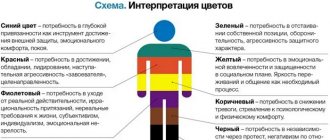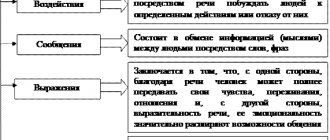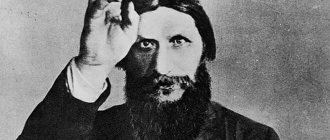Departments
The analyzer is a collection of neurons, which is often called the sensory system. Any analyzer has three sections:
- peripheral - sensitive nerve endings (receptors) that are part of the sense organs (vision, hearing, taste, touch);
- conductive - nerve fibers, a chain of different types of neurons that conduct a signal (nerve impulse) from receptors to the central nervous system;
- central - a section of the cerebral cortex that analyzes and converts the signal into sensation.
Rice.
1. Analyzer departments. Each specific analyzer corresponds to a specific area of the cerebral cortex, which is called the cortical nucleus of the analyzer.
LECTURE 9. ANALYZERS
Plan
1. General concept of analyzers.
2. Visual analyzer.
3. Auditory and vestibular analyzers.
4. Olfactory and taste analyzers.
5. Motor analyzer.
General concept about analyzers. Human life is inextricably linked with the external environment. He receives a huge flow of information about the world around him thanks to the influence of various stimuli on sensitive endings - receptors located both in special sensory organs (eye, ear) and in all other organs (skin, muscles, internal organs, etc.). During evolution, humans have developed specialized receptors that perceive a certain type of stimulus (light, sound, temperature, etc.). Excitation from receptors enters the cerebral cortex. In the corresponding zones of the cortex, the discrimination of stimuli that began in the receptors is completed and visual, sound and other sensations arise.
Systems of sensitive nervous formations that perceive and analyze external and internal stimulation, I.P. Pavlov called them analyzers. The analyzers include: a receptor (the peripheral part of the analyzer), a conductive part and a central part of the analyzer, represented by the corresponding area of the cerebral cortex. All parts of the analyzer are interconnected and act as a single whole, so a violation of one of its parts leads to the loss of the ability to distinguish between certain irritations.
Classification of receptors. A receptor is a specialized structure that, in the process of evolution, has adapted to the perception of a specific stimulus. Analyzer receptors are classified according to different criteria. Based on sensitivity to certain stimuli, they are divided into: mechanoreceptors, chemoreceptors, thermoreceptors, photoreceptors, nociceptors. Based on their location in the body, receptors are divided into extero- and interoreceptors. Based on the speed of adaptation, receptors are divided into three groups: rapidly adapting (phasic) and slowly adapting (tonic). Based on their structural and functional organization, primary and secondary receptors are distinguished.
Transduction of signals in receptors. When a stimulus acts on a receptor cell, a change in the permeability of the membrane for certain ions (sodium and potassium) occurs. Ionic currents arise, which lead to the generation of a receptor potential (RP). Further, the excitation process proceeds in different ways. In primary sensitive receptors, the receptor potential acts on neighboring areas of the membrane, where an action potential is generated, which then spreads in the form of impulses along the nerve fiber. In secondary sensitive receptors, the receptor potential leads to the formation and release of a transmitter from the presynaptic section of the receptor cell into the synaptic cleft of the receptor-afferent synapse. This transmitter acts on the postsynaptic membrane of the sensitive neuron, causing its depolarization and the formation of a postsynaptic potential, which is called the generator potential (GP). The latter acts on extrasynaptic areas of the membrane of a sensitive neuron and causes the generation of an action potential.
Visual analyzer. A person receives the largest amount of information (up to 90%) about the outside world through the organ of vision. The organ of vision - the eye - consists of the eyeball and an auxiliary apparatus. The auxiliary apparatus includes the eyelids, eyelashes, lacrimal glands and muscles of the eyeball. The eyelids are formed by folds of skin lined from the inside with a mucous membrane - the conjunctiva. The lacrimal glands are located in the outer upper corner of the eye. Tears wash the anterior part of the eyeball and enter the nasal cavity through the nasolacrimal duct. The muscles of the eyeball set it in motion and direct it towards the object in question.
The eyeball is spherical in shape and located in the orbit. It contains three membranes: fibrous (outer), vascular (middle) and retina (inner). The fibrous membrane in its posterior section forms a dense tunica albuginea, or sclera, which gives the eyeball a certain shape, and in the anterior section - a transparent cornea. The choroid is rich in blood vessels and pigments. It consists of the choroid proper (the posterior part), the ciliary body, and the iris, or iris. The bulk of the ciliary body is the ciliary muscle, which changes the curvature of the lens through its contraction. The iris has the appearance of a ring, the color of which depends on the amount and nature of the pigment. Between the cornea and the iris there is a space filled with aqueous humor - the anterior chamber of the eye. In the center of the iris there is a small hole - the pupil, which, by reflexively expanding or contracting, lets more or less light rays into the eye. Behind the iris is a transparent and elastic lens - a biconvex lens with a diameter of 10 mm. Between the iris and the lens is the posterior chamber of the eye, filled with aqueous humor. The vitreous body lying behind the lens fills almost the entire internal cavity of the eyeball.
The retina has a very complex structure. It contains light-receiving cells - rods and cones. Rods (130 million) are more sensitive to light. They are called twilight vision apparatus. Cones (7 million) are the apparatus for daytime and color vision. When these cells are irritated by light rays, excitation occurs, which is carried through the optic nerve to the visual centers located in the occipital zone of the cerebral cortex. The area of the retina from which the optic nerve emerges is devoid of rods and cones and is therefore incapable of perceiving light. It is called a blind spot. Almost next to it is a yellow spot formed by a cluster of cones - the place of best vision.
The optical, or refractive, system of the eye includes: the cornea, aqueous humor, lens and vitreous body. In people with normal vision, rays of light passing through each of these media are refracted and then hit the retina, where they form a reduced and inverted image of objects visible to the eye. Of these transparent media, only the lens is capable of actively changing its curvature, increasing it when viewing close objects and decreasing it when looking at distant objects. This ability of the eye to clearly see objects at different distances is called accommodation. If rays are refracted too strongly when passing through transparent media, they are focused in front of the retina, resulting in myopia. In such people, the eyeball is either elongated or the curvature of the lens is increased. The weak refraction of these media causes the rays to focus behind the retina, causing farsightedness. It occurs due to shortening of the eyeball or flattening of the lens. Properly selected glasses can correct these vision defects.
Conducting pathways of the visual analyzer. The first, second and third neurons of the visual analyzer pathway are located in the retina. The fibers of the third (ganglionic) neurons in the optic nerve partially intersect to form the optic chiasm. After the chiasm, the right and left visual tracts are formed. The fibers of the optic tract end in the diencephalon (nucleus of the lateral geniculate body and the thalamic cushion), where the fourth neurons of the optic tract are located. A small number of fibers reach the midbrain in the area of the superior colliculus. The axons of the fourth neurons pass through the posterior leg of the internal capsule and are projected onto the cortex of the occipital lobe of the cerebral hemispheres, where the cortical center of the visual analyzer is located.
Auditory and vestibular analyzers. The organ of hearing and balance includes three sections: the outer, middle and inner ear. The outer ear consists of the pinna and the external auditory canal. The auricle is made of elastic cartilage covered with skin and serves to capture sound. The external auditory canal is a 3.5 cm long canal that begins with the external auditory opening and ends blindly with the eardrum. It is lined with skin and has glands that secrete earwax.
Behind the eardrum is the middle ear cavity, which consists of the air-filled tympanic cavity, the auditory ossicles and the auditory (Eustachian) tube. The auditory tube connects the tympanic cavity with the cavity of the nasopharynx, which helps equalize the pressure on both sides of the eardrum. The auditory ossicles—the malleus, the incus, and the stapes—are movably connected to each other. The hammer is fused with the handle to the eardrum; the head of the malleus is adjacent to the anvil, which at the other end is connected to the stapes. The stapes is connected with a wide base to the membrane of the oval window leading to the inner ear.
The inner ear is located in the thickness of the pyramid of the temporal bone; consists of a bony labyrinth and a membranous labyrinth located in it. The space between them is filled with fluid - perilymph, the cavity of the membranous labyrinth - endolymph. The bony labyrinth contains three sections: the vestibule, the cochlea and the semicircular canals. The cochlea belongs to the organ of hearing, the rest of its parts belong to the organ of balance.
The cochlea is a bone canal twisted in the form of a spiral. Its cavity is divided by a thin membranous septum - the main membrane. It consists of numerous (about 24 thousand) connective tissue fibers of different lengths. The receptor hair cells of the organ of Corti, the peripheral part of the auditory analyzer, are located on the main membrane.
Sound waves through the external auditory canal reach the eardrum and cause its vibrations, which are amplified (almost 50 times) by the auditory ossicle system and transmitted to the perilymph and endolymph, then perceived by the fibers of the main membrane. High sounds cause vibrations of short fibers, low sounds cause vibrations of longer ones located at the top of the cochlea. These vibrations excite the receptor hair cells of the organ of Corti. Next, the excitation is transmitted along the auditory nerve to the temporal lobe of the cerebral cortex, where the final analysis and synthesis of sound signals occurs. The human ear perceives sounds with a frequency of 16 to 20 thousand Hz.
Conducting paths of the auditory analyzer. The first neuron of the auditory analyzer pathways is the bipolar cells mentioned above. Their axons form the cochlear nerve, the fibers of which enter the medulla oblongata and end in the nuclei where the cells of the second neuron of the pathways are located. The axons of the cells of the second neuron reach the internal geniculate body, mainly the opposite side. The third neuron begins here, along which impulses reach the auditory area of the cerebral cortex.
In addition to the main conducting path connecting the peripheral part of the auditory analyzer with its central, cortical part, there are other paths through which reflex reactions to irritation of the organ of hearing in an animal can be carried out even after the removal of the cerebral hemispheres. Indicative reactions to sound are of particular importance. They are carried out with the participation of the quadrigeminal, to the posterior and partly anterior tubercles of which there are collaterals of fibers directed to the internal geniculate body.
Vestibular apparatus. It is represented by the vestibule and semicircular canals and is an organ of balance. In the vestibule there are two sacs filled with endolymph. At the bottom and in the inner wall of the sacs there are receptor hair cells, which are adjacent to the otolithic membrane with special crystals - otoliths containing calcium ions. The three semicircular canals are located in three mutually perpendicular planes. The bases of the canals at the points of their connection with the vestibule form extensions - ampoules in which hair cells are located.
Receptors of the otolithic apparatus are excited by accelerating or decelerating rectilinear movements. The receptors of the semicircular canals are irritated by accelerated or slowed rotational movements due to the movement of endolymph. Excitation of the receptors of the vestibular apparatus is accompanied by a number of reflex reactions: changes in muscle tone that promote straightening of the body and maintaining posture. Impulses from the receptors of the vestibular apparatus travel along the vestibular nerve to the central nervous system. The vestibular analyzer is connected to the cerebellum, which regulates its activity.
Conducting pathways of the vestibular apparatus. The conductive path of the statokinetic apparatus transmits impulses when the position of the head and body changes, participating together with other analyzers in the body’s approximate reactions relative to the surrounding space. The first neuron of the statokinetic apparatus is located in the vestibular ganglion, which lies at the bottom of the internal auditory canal. The dendrites of the bipolar cells of the vestibular ganglion form the vestibular nerve, formed by 6 branches: superior, inferior, lateral and posterior ampullary, utricular and saccular. They contact the sensitive cells of the auditory maculae and scallops located in the ampoules of the semicircular canals, in the sac and uterus of the vestibule of the membranous labyrinth.
Sensitive cells of the auditory maculae and scallops perceive the displacement of the endolymph of the semicircular canals and the vestibule of the membranous labyrinth with the slightest change in the position of the head, with linear acceleration and rotation in three planes. Axons, i.e., processes of bipolar cells of the vestibular ganglion, form the vestibular part of the VIII pair of cranial nerves together with the cochlear nerve, which leaves the pyramid of the temporal bone through the internal auditory foramen, in the cerebellopontine angle penetrates the substance of the dorsal part of the pons and medulla oblongata, reaching the superior, lateral, medial and spinal nuclei. A small number of fibers, bypassing the nuclei, go directly to the cerebellum to the uvula, apex, nodule, uvula of the vermis, and nucleus of the tent.
The primary afferents of the vestibular nerve terminate mainly in the region of the vestibular nuclei of the medulla oblongata. There are four of them on each side, differing from each other both anatomically and functionally: superior (Bechterew's), medial, lateral and inferior nuclei. The impulses coming into them from the vestibular receptors themselves do not provide accurate information about the position of the body in space, since the angle of rotation of the head due to the mobility of the neck joints does not depend on the orientation of the body. The central nervous system must also take into account the position of the head relative to the body. Consequently, the vestibular nuclei receive additional afferentation from cervical muscle and joint receptors. The vestibular nuclei also receive somatosensory signals from other joints (legs, arms).
There are connections between the 4 vestibular nuclei, as well as bilateral connections with the nuclei of the reticular formation. From the vestibular lateral nucleus, the vestibulospinal tract begins, which runs in the anterior part of the lateral cord of the spinal cord and ends on the motor neurons of the anterior columns. Some of the axons of the neurons of the lateral nucleus are directed to the medial longitudinal fascicle of the same and opposite sides, which combines the function of the III, IV, V, VI pairs of cranial nerves into one whole. In turn, from the medial and spinal vestibular nuclei, axons go to the nuclei of the oculomotor nerve of the opposite side, and from the superior nucleus to the oculomotor nucleus of the same side. From the medial nucleus, axons go to the nucleus of the abducens nerve.
Thus, the axons of neuron II of the 4 vestibular nuclei form connections with the cerebellum through the vestibulocerebellar tract, with the spinal cord (anterior columns) through the vestibulospinal tract, with the reticular formation (midbrain, hindbrain and medulla oblongata) through the vestibuloreticular tract, with the tegmental nuclei of the midbrain - through vestibulopectoral tract, with the medial longitudinal fasciculus through the tract of the same name, directly with the nuclei of the III, IV, VI pairs of cranial nerves and the nuclei of the thalamus.
The axons of the superior, lateral, medial and spinal nuclei of the vestibular nerve, in addition to the connections described, form internal arcuate fibers in the medulla oblongata and, connecting to the medial lemniscus bundle, reach the lateral nucleus of the thalamus, where they form synaptic contacts with the third neuron. From the thalamus, fibers are sent to the cortical balance centers located in the middle temporal gyrus, frontal and parietal lobes. Most likely, these cells are scattered throughout the cerebral cortex.
Many connections enable the vestibular system to play a central role in generating motor efferentation, ensuring the maintenance of the desired body position and appropriate oculomotor reactions. In this case, the vertical posture and gait are determined mainly by the otolithic apparatus, and the semicircular canals control mainly the direction of gaze. It is the afferentation from the semicircular canals, together with the oculomotor mechanisms, that provides visual contact with the environment during head movements. When it rotates or tilts, the eyes move in the opposite direction, so the image on the retina does not change. Horizontal compensatory eye movements are controlled by the horizontal semicircular canal, vertical ones by the anterior vertical canal, and rotation by the posterior vertical canal.
Another important part of the central nervous system involved in these processes is the cerebellum, which receives some primary vestibular afferents (the so-called direct sensory cerebellar pathway) in addition to the secondary ones discussed above. All of them in mammals end in the cerebellum with mossy fibers on the cells of the nodule and flocculus, which belong to the ancient cerebellum, and partially in the uvula and near the flocculus of the old cerebellum.
Olfactory and gustatory analyzers. The olfactory analyzer provides the perception of smell. Olfactory receptors are located in the mucous membrane of the upper part of the nasal cavity. Particles of odorous substances in the inhaled air serve as irritants to nerve cells. Impulses from the olfactory receptors enter the olfactory cortex along the olfactory nerve.
The peripheral section of the taste analyzer is represented by a set of taste buds located in the epithelium of the papillae of the tongue. The taste bud consists of taste (receptor) cells, the irritants of which are substances soluble in water. Receptors specific to the perception of sweet are located at the tip of the tongue, bitter - on the root, sour and salty - on the sides of the tongue. The central sections of the taste and olfactory analyzers are concentrated on the inner surface of the temporal and frontal lobes of the cerebral cortex.
Motor analyzer. Movement is one of the manifestations of life activity, providing the possibility of active interaction of the body with the environment. In most animals and humans, movements are the result of contraction of skeletal muscles that maintain posture and move individual parts of the body or the entire body in space. During movement, some muscles alternately contract and others relax. There are movements that provide flexion, extension, adduction, abduction and rotation of the limbs in the joint. Movements can be simple (for example, withdrawing a hand when touching a hot object) and complex - a series of sequential movements aimed at solving a specific motor task, directions of movement that ensure the movement of the body in space (walking, running, swimming, jumping, etc.). ). The most complex movements include the so-called special movements - work, sports, dance.
Movements that ensure the completion of a particular task and are realized in successive muscle contractions are also called voluntary, or conscious, movements, and simple, reflex movements are called involuntary.
All levels of the nervous system (spinal cord, various structures of the brain, peripheral nerves), as well as the musculoskeletal system, are involved in the formation, regulation and implementation of voluntary movements.
The musculoskeletal system consists of skeletal bones with joints, ligaments and muscles with tendons, which provide the supporting function of the body. With the help of skeletal muscles, both static (fixation of the body in a certain position) and dynamic (movement of the body in space and its individual parts relative to each other) activity is carried out. Both types of muscle activity closely interact, complementing each other. Various parts of the central nervous system participate in the coordination of movements, that is, in ensuring the coordinated activity of various muscle groups; the leading role in ensuring their interaction belongs to the cerebral cortex. Schematically, the control of voluntary movements can be represented as follows. The tasks and purpose of a motor action are formed in the process of thinking, which determines the direction of a person’s attention and efforts. Analyzers play a major role in the implementation of motor reactions. The motor analyzer ensures the dynamics and interrelation of muscle contractions and participates in the spatial and temporal organization of the motor act. The vestibular analyzer interacts with the motor analyzer when the body position in space changes. Vision and hearing are involved in orientation and correction of motor reactions.
A motor analyzer is a neurophysiological system that analyzes and synthesizes signals arising in the organs of movement of humans or animals. The motor analyzer consists of a peripheral section, specific nerve fibers (sensory nerves carrying nerve impulses to the brain), subcortical structures and a cortical section located in the frontal lobes of the cerebral cortex.
The motor analyzer is closely related to the function of the motor cortex, the neurons of which send impulses to the anterior parts of the spinal cord and to the neurons of the nuclei of the motor cranial nerves, as well as to the thalamus, the basal ganglia, the red nucleus and the cerebellum. These are direct connections through which “orders” go from the cerebral cortex to the muscles. When movements occur according to these “orders,” nerve impulses appear in the proprioceptors, traveling along the afferent (sensitive) nerve fibers of the motor analyzer from the muscles to the cerebral cortex, through the intervertebral nerve ganglia, dorsal roots of the spinal cord, medulla oblongata, and thalamus. In addition to this pathway, proprioceptive signals can reach the cerebral cortex through the reticular system and the cerebellum. The motor analyzer is involved in maintaining constant tone (tension) of the body muscles and coordination of movements. In higher animals and humans, the motor analyzer models movement, creates, as it were, an image of the movement to be performed, and constantly compares the real flow of afferent impulses from muscle movement with its pre-created image - a plan (the “action acceptor” mechanism, according to P.K. Anokhin ). In this sense, the motor analyzer is often called a kinesthetic analyzer . The speech motor analyzer is located in the left frontal lobe (inferior frontal gyrus). According to I.P. Pavlov, this is a “basal component,” the neurophysiological basis of human abstract thinking.
Motor functions. The cortical section of the motor analyzer is located mainly in the anterior central gyrus, anterior to the central (Rolandic) sulcus. In this area there are nerve cells, the activity of which is associated with all movements of the body. The processes of large nerve cells located in the deep layers of the cortex descend into the medulla oblongata, where a significant part of them intersect, that is, go to the opposite side. After the transition, they descend along the spinal cord, where the rest of the cord intersects. In the anterior horns of the spinal cord they come into contact with the motor nerve cells located here. Thus, the excitation that arises in the cortex reaches the motor neurons of the anterior horns of the spinal cord and then travels through their fibers to the muscles. Due to the fact that in the medulla oblongata, and partly in the spinal cord, a transition (crossing) of the motor pathways to the opposite side occurs, the excitation that arose in the left hemisphere of the brain enters the right half of the body, and impulses from the right hemisphere enter the left half of the body.
The position of some cortical ends of various analyzers (nuclei) in relation to the gyri and lobes of the cerebral hemispheres in humans:
1. The core of the motor analyzer is located mainly in the so-called motor cortex, which includes the precentral gyrus and paracentral lobule on the medial surface of the hemisphere. The 5th layer of the cortex of the precentral gyrus contains giant pyramidal neurons (Betz cells).
2. In the region of the inferior parietal lobule, in the supramarginal gyrus, there is the nucleus of the motor analyzer, the functional significance of which is to carry out the synthesis of all purposeful complex combined movements. This core is asymmetrical. For right-handers it is located in the left hemisphere, and for left-handers it is in the right hemisphere. The ability to coordinate these complex goal-directed movements is acquired by the individual throughout life as a result of practical activity and accumulation of experience. Purposeful movements occur due to the formation of temporary connections between cells located in the precentral and supramarginal gyri.
3. The nucleus of the motor analyzer of written speech (an analyzer of voluntary movements associated with writing letters and other characters) is located in the posterior part of the middle frontal gyrus. It is closely adjacent to those parts of the precentral gyrus, which are characterized by the function of the motor analyzer of the hand and the combined rotation of the head and eyes in the opposite direction.
4. The core of the motor analyzer of speech articulation (speech motor analyzer) is located in the posterior parts of the inferior frontal gyrus. This nucleus borders on those parts of the precentral gyrus that are analyzers of movements produced by contraction of the muscles of the head and neck. This is understandable, since the speech motor analyzer analyzes the movements of all muscles: lips, cheeks, tongue.
The formation and improvement of movement occurs under the influence of education and constant training. Newborns have virtually no voluntary movements. Although many motor reactions of an infant are instinctive (at a certain age he begins to crawl, then tries to sit and stand on his legs), stable motor skills are acquired by him through constant training. This is especially important when training labor movements.
Physical activity has a beneficial effect on blood circulation and metabolism. It maintains muscle tone, increases the vitality of the body, and its resistance to harmful environmental factors. Lack of physical activity (hypodynamia) adversely affects the condition of all organs and systems of the body, contributes to the development of obesity, atherosclerosis, hypertension, and coronary heart disease. Physical inactivity is compensated for when engaging in physical education, sports, or any physical work. This goal, in particular, is pursued by the breaks from work established for people of many professions to practice industrial gymnastics, the massive development in our country of the physical education movement, tourism, etc. However, physical activity should be dosed in accordance with the capabilities of the body. Physical therapy is the study and use of movements as a therapeutic factor.
Kinds
Receptors, and therefore analyzers, can be of two types:
- external (exteroceptors) - located near or on the surface of the body and perceive environmental stimuli (light, heat, humidity);
- internal (interoceptors) - located in the walls of internal organs and perceive stimuli from the internal environment.
Rice.
2. Location of perception centers in the brain. Six types of external perception are described in the table “Human Analyzers”.
| Analyzer | Receptors | Pathways | Central departments |
| Visual | Retinal photoreceptors | Optic nerve | Occipital lobe of the cerebral cortex |
| Auditory | Hair cells of the spiral (or Corti) organ of the cochlea | Auditory nerve | Superior gyrus of the temporal lobe |
| Flavoring | Tongue receptors | Glossopharyngeal nerve | Anterior temporal lobe |
| Tactile | Receptor cells: – on bare skin – Meissner corpuscles, located in the papillary layer of the skin; – on the hair surface – hair follicle receptors; – vibrations – Pacinian corpuscles | Musculoskeletal nerves, spinal cord, medulla oblongata, diencephalon | Posterior central gyrus of the parietal lobe |
| Olfactory | Receptors of the nasal cavity | Olfactory nerve | Anterior temporal lobe |
| Temperature | Heat (Ruffini corpuscles) and cold (Krause flasks) receptors | Myelinated (cold) and unmyelinated (warm) fibers | Posterior central gyrus of the parietal lobe |
Rice.
3. Location of receptors in the skin. Internal receptors include pressure receptors, vestibular apparatus, kinesthetic or motor analyzers.
TOP 4 articles
who are reading along with this
Taste
Visual analyzer
Smell
Structure and functions of the eye
Monomodal receptors perceive one type of irritation, bimodal - two types, polymodal - several types. For example, monomodal photoreceptors perceive only light, tactile bimodal ones perceive pain and heat. The vast majority of pain receptors (nociceptors) are polymodal.
Deviation from the norm
The analyzers through which a person perceives information about the surrounding world are susceptible to disorders that can lead to dangerous deviations:
- Visual. Increased intraocular pressure, decreased visual acuity, incorrect perception of light and color sensations, changes in the field of vision. Disorders develop against the background of glaucoma, lens opacity, myopia, and dry eyeball.
- Auditory. Distorted perception of sounds, hearing impairment, appearance of extraneous noise. They develop against the background of otitis media, Meniere's disease, sudden deafness, and inflammatory processes.
- Tactile. Decreased skin sensitivity (tactile, pain, temperature, vibration), decreased sensitivity of perception of signals from muscle fibers.
Taste disorders include dulling of the perception of tastes. A person ceases to fully feel spicy, salty, bitter or sweet foods.
Characteristics
Analyzers, regardless of type, have a number of common properties:
- high sensitivity to stimuli, limited by the threshold intensity of perception (the lower the threshold, the higher the sensitivity);
- difference (differentiation) of sensitivity, allowing one to distinguish stimuli by intensity;
- adaptation, which allows you to adjust the level of sensitivity to strong stimuli;
- training, manifested both in a decrease in sensitivity and in its increase;
- preservation of perception after the cessation of the stimulus;
- interaction of different analyzers with each other, allowing you to perceive the completeness of the outside world.
An example of a peculiarity of the analyzer's operation is the smell of paint. People with a low threshold for sensitivity to odors will smell more strongly and react actively (lacrimation, nausea) than people with a high threshold. Analyzers will perceive a strong odor more intensely than other surrounding odors. Over time, the smell will not be felt sharply, as adaptation will occur. If you constantly stay in a room with paint, the sensitivity will become dull. However, when you leave the room into the fresh air, you will feel the smell of paint for some time.
Characteristic
Characteristics:
- The upper threshold of sensations. The maximum magnitude of the stimulus that the receptor can perceive without distorting the data.
- The lower threshold of sensations. The minimum magnitude of the stimulus, which is manifested by sensations that are difficult to notice. The weakest signals may not be felt at all.
- Operational threshold. The magnitude of the difference between individual signals, in which the speed and accuracy are maximized.
- Differential threshold. Smallest differences between stimuli.
- Intensity of sensations.
Sensitivity interval is the range between the upper and lower thresholds of sensations.
Test on the topic
- /10
Question 1 of 10What is the conductor section of the analyzer?
Start test
Hall of Fame
To get here, take the test.
- Anastasia Skorinova
10/10
- Dmitry Lyutik
8/10
- Sergey Ardashev
10/10
- Alina Kozlova
10/10
- Pavel Zherebtsov
10/10
Anterior chamber of the eye
The anterior chamber of the eye is the space between the iris and cornea, filled with a viscous fluid. Behind the iris there is a biconvex lens 10 mm in diameter - an elastic and transparent lens. It is attached to the ciliary muscle, which is located in the choroid. If the tension of the ligaments decreases, that is, the ciliary muscle relaxes, the lens becomes more convex due to its elasticity and elasticity, and vice versa, the lens thickens as the tension of the ligaments increases.
The posterior chamber of the eye is filled with fluid and is located between the lens and the iris. Behind the lens, the cavity of the eyeball is filled with a transparent gelatinous mass, the so-called vitreous body, which is designed to maintain the shape of the eyeball, give it elasticity and, in addition, keep it in contact with the sclera and the choroid of the retina. This is the basic principle of operation of the senses and analyzers.
Mechanism of sound perception
The fluids of the cochlear canals receive the vibrations of the stapes, which rests on the membrane of the oval window. This leads to resonant vibrations of the fibers of the main membrane. In particular, a high tone of sounds causes vibrations of short fibers, which are located at the base of the cochlea, and a low tone causes vibrations of long fibers located at the top. At the same time, the hair cells touch the covering membrane, changing their shape.
Hair cells, touching the covering membrane, change shape. This leads to the appearance of excitation, transmitted to the midbrain in the form of impulses along the fibers of the auditory nerve and further to the hearing zone of the cerebral cortex of the temporal lobe, where excitation turns into an auditory sensation. The human ear can perceive a frequency range of sounds of 20-20,000 Hertz.
Hearing hygiene
To preserve hearing, it is necessary to prevent mechanical damage to the eardrum. The ear canal and ears should be kept clean. If excess wax accumulates in your ears, you need to contact a specialist. Strong and prolonged noise has a detrimental effect on the hearing organ. It is very important to treat colds in a timely manner, since pathogenic bacteria can penetrate into the tympanic cavity through the Eustachian tube and provoke inflammation. We looked at human analyzers and sense organs.
Hygiene of the organ of vision
Factors that help preserve vision:
- the light source is located on the left;
- the workplace should be well lit;
- from the eye to the subject of consideration, the distance should be approximately 30-35 centimeters.
Reading in transport also leads to deterioration of vision (since the constantly changing distance between the lens and the book leads to a weakening of the elasticity of the ciliary muscle and lens) or lying down. You should protect your eyes from exposure to very bright light, dust and other particles. There are also equally important sense organs and analyzers. Anyone can pass the biology test.
Functions
The following processes are carried out in turn in the analyzers:
- signal detection;
- signal discrimination;
- transmission and conversion of signals;
- signal recognition;
- pattern recognition.
The purpose of the transmission and transformation processes is to convey information to the brain in a convenient form. Therefore, only important information is selected, unnecessary information is eliminated.
Pattern recognition is the final operation of the analyzer. A person recognizes an image, assigns it to a category, considers it important or unimportant.









